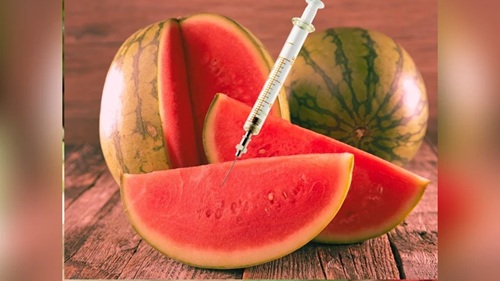Watermelon is one of the most popular fruits in India, especially during summer, due to its juicy, refreshing taste and high water content. However, in recent years, concerns have arisen about injected watermelons, where unscrupulous sellers add artificial sugar, water, or chemicals to enhance sweetness or weight. Consuming such watermelons can lead to health issues, including stomach upset and long-term toxicity. Therefore, knowing how to identify injected watermelons is essential for safe consumption.

1. Understanding Injected Watermelon
- Injected watermelon refers to fruit that has been tampered with by adding external sugar solutions, water, or chemicals to increase sweetness or volume.
- The practice is illegal and dangerous, as it alters the natural composition of the fruit and can introduce harmful substances.
- Identifying injected watermelons requires attention to color, texture, sound, and taste.
2. Physical Characteristics of Original Watermelon
a) Color and Rind
- Natural watermelons have a deep green rind with light green or yellow stripes.
- The part that touches the ground, called the field spot, is usually creamy yellow, indicating ripeness.
- Injected watermelons may appear too glossy, uniform in color, or unnaturally bright, which is a sign of chemical treatment.
b) Shape
- Fresh watermelons are typically slightly irregular in shape and size.
- Perfectly uniform, symmetrical watermelons may indicate artificial tampering or selective chemical growth.
c) Weight
- Watermelon should feel heavy for its size, reflecting its natural water content.
- If a watermelon feels too light or unusually heavy, it may have been injected with water or sugar solution.
3. Sound Test (Knock Test)
- Gently tap the watermelon with your knuckles.
- A natural watermelon produces a deep, hollow sound, indicating ripeness and uniform internal water content.
- Injected watermelons may produce a dull, uneven, or inconsistent sound, as the injected solution affects the natural structure.
4. Texture and Flesh Inspection
- Cut a small piece and observe the flesh color.
- Authentic watermelon flesh is bright red or pink, firm, and juicy, with white seeds naturally embedded.
- Injected watermelons may have excessive sweetness, watery texture, or uneven coloration. The flesh may feel spongy or unusually soft.
5. Taste Test
- Natural watermelon tastes refreshing, slightly sweet, and hydrating, with no chemical aftertaste.
- Injected watermelon may taste overly sweet, artificial, or sticky, which is a clear indicator of sugar solution injection.
6. Quick Practical Tips to Identify Injected Watermelon
| Feature | Natural Watermelon | Injected Watermelon |
| Rind Color | Deep green with natural stripes | Too uniform, glossy, or bright |
| Field Spot | Creamy yellow | Pale or inconsistent |
| Weight | Heavy for its size | Too heavy or too light |
| Shape | Slightly irregular | Perfectly symmetrical |
| Sound (Knock Test) | Deep, hollow | Dull, inconsistent |
| Flesh Texture | Firm, juicy, evenly colored | Spongy, watery, uneven color |
| Taste | Refreshing, mild natural sweetness | Overly sweet, artificial taste |
7. Precautions When Buying Watermelon
- Buy from trusted vendors or local markets known for natural produce.
- Avoid watermelons that appear too perfect, glossy, or overly heavy.
- Observe the field spot, rind texture, and natural color variations.
- When cutting, inspect for even flesh texture and natural sweetness.
8. Final Thoughts
Identifying injected watermelon requires careful observation of color, weight, sound, texture, and taste. Genuine watermelons have natural imperfections, deep red flesh, and refreshing sweetness, while injected fruits often appear unnaturally glossy, overly sweet, or spongy. By following these simple tests and purchasing from reliable sources, consumers can ensure safety and enjoy the true taste of this summer favorite.